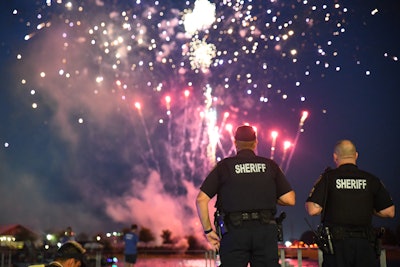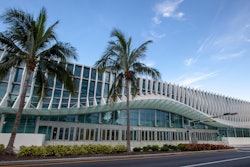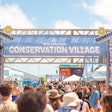
Over the course of the last 18 months, when we, as an industry, discussed a “safe” event, we were usually referring to COVID-19 protocols, social distancing measures and vaccine mandates. But the recent Astroworld tragedy has brought into focus the importance of developing and executing a comprehensive event safety plan—because the coronavirus isn’t the only potential danger that attendees and staff might face.
So what does it mean to produce a safe event nowadays? Of course, not all events are the same. Even annual events that occur at the same venue must adapt year to year, taking into consideration the current conditions.
We asked some industry experts to share their insights into the concert disaster in Houston, as well as their advice for addressing common safety issues and concerns such as crowd management. Here’s what you need to know in order to plan a safe live event.
Indoor vs. Outdoor Venues
When analyzing a site or venue, planners need to consider if the space can accommodate the demands of that particular event, including capacity and infrastructure needs like running water, drainage and sewage. For example, an open field may offer the space needed, but the terrain or road access may prove to be obstacles to hosting a safe event.
“The location and type of venue are among many factors to be considered by the people planning crowd management and event security. For example, Astroworld was an outdoor festival on a parking area in Houston; Tanglewood is an outdoor music space on a lawn in the Berkshires. The location of the event, without knowing much more, tells you little about the reasonably foreseeable crowd or the resulting issues to be addressed,” explains Steven Adelman, vice president of Event Safety Alliance, which has published an extensive Event Safety Guide for planners.
Steve Allen, founder of Crowd Safety, a U.K.-based event safety consulting firm that provides professional crowd, fire and event safety services, agrees, saying that both indoor and outdoor venues have their own risks, depending on the type of event and how the space is being used. “Is it a free event, ticketed event, concert, festival, camping, family event?” he asks.
He adds that “indoor events can have just as many risks as outdoor events, depending on the type of event, demographics and current external threats,” such as terrorism, citing the attack that took place at the Ariana Grande concert in Manchester in 2017.
“Fans are typically inside a building, convention center, stadium, etc. This has its own set of issues when it comes to orderly exits; crowd movement; active shooter-type incidents; noise level, which often makes it hard for first responders to communicate; and air quality threats/contamination,” explains Pete Eliadis, president and CEO of Intelligence Consulting Partners, a consulting company that assists in planning large-scale events in the U.S. and internationally.
Regardless of the type of gathering, though, there are some standard safety practices planners need to consider for most events, including entry screening of patrons, such as via the use of metal detectors; accommodations for individuals with movement disabilities; the need for fire and medical stations; parking; an exit strategy for fans and vehicles; and, in the event of an incident, communication protocols that take into account inundated cell service, Eliadis says.
Every Event Needs Its Own Plan
“No two events are the same and as such should be treated differently,” says Allen, who has served as the head of security and crowd safety for bands such as Oasis and The Rolling Stones. “An example would be where the venue was the same, say Wembley Arena, having three concerts over three consecutive nights with three different artists. Same venue, same type of event—however, the artists were One Direction, Paul McCartney and Stormzy. Each will bring completely different crowd profiles and, as such, risk in terms of crowds, and will each require a slightly different approach.”
This also applies to the use of a venue. Depending on how it’s being utilized, the safety strategy for a particular space needs to be adjusted. “An outdoor event in a stadium differs from that in an urban city center or rural-urban greenfield site,” Allen says. “When a stadium is opened up for concerts with standing crowds on a pitch, the stadium takes on a whole new dynamic,” as compared to a typical game day with seated attendees.
Eliadis warns against organizers becoming too comfortable, which leads to safety oversights. “Individuals involved with special events often become complacent. They often rely on past proven success from previous events.”
As for determining the appropriate number of medical and security staff personnel, Adelman says it depends on the “foreseeable behavior of the people” who will be attending the event. “Astroworld was anticipated to draw an active crowd, meaning that cuts and bruises would be common medical issues. To continue the Tanglewood analogy, classical music tends to draw an older demographic for whom AEDs [automated external defibrillators] are more necessary. The event medical staffing calculation, like security staffing, requires consideration of everything about the particular crowd, event, time of year, weather and so on. There’s no objective mathematical formula that works everywhere all the time.”
Ultimately, the goal of the event organizer is to minimize the effects of an event on the local hospital facilities and emergency medical services.
On-Site Staff Safety
While attendee safety is top of mind for planners, measures to ensure the on-site staff is protected also need to be considered. Eliadis recommends establishing clear boundaries in regard to expected crowd behavior; providing identifiable vests; working in teams of two or more; having a clear communication channel with first responders; and sharing information prior to the event. For example, notify attendees about the bag policy—e.g., backpacks will not be allowed—to help things run more smoothly for on-site personnel.
“Each event safety management plan will normally start with ‘we take the safety of all involved as paramount.’ This statement would undoubtedly be the starting point,” Allen says. And planners should “ensure this isn’t just lip service.”



















